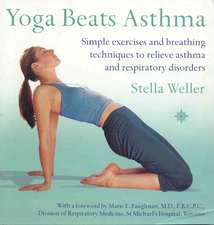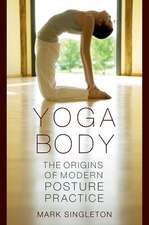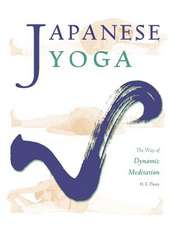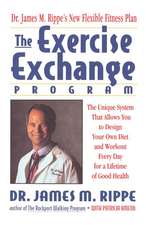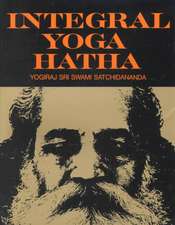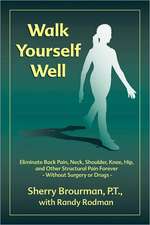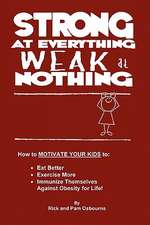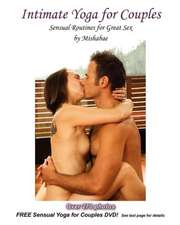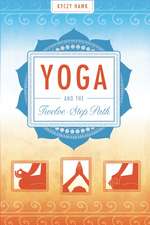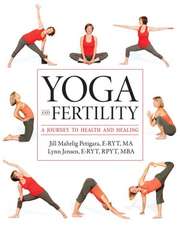The Complete Book of ABS: Revised and Expanded Edition
Autor Kurt Brungardten Limba Engleză Paperback – 31 aug 1998
¸ The first ab book for everyone--from beginners to fitness professionals
¸ More than one hundred ab exercises--from traditional crunches and sit-ups to such cutting-edge techniques as corkscrews and hanging knee raises--drawn from diverse sources, including gymnastics, yoga, and the martial arts
¸ Includes the "Fifteen Minutes a Day to Ultimate Abs" system, which will take you from an undeveloped stomach to a rippled washboard look in six months
¸ Dozens of favorite and new routines from America's foremost coaches, trainers, and bodybuilders
¸ How to be your own personal trainer and put together your own routines
¸ The most up-to-date information on diet and nutrition, including a personal
template to maximize diet-exercise efficiency
Already a fitness classic, The Complete Book of Abs, is the definitive guide for abdominal toning and strengthening. No one who's serious about working out should be without it.
Preț: 143.01 lei
Nou
27.37€ • 28.47$ • 22.59£
Carte în stoc
Livrare din stoc 05 martie
Specificații
ISBN-10: 0375751432
Pagini: 288
Dimensiuni: 217 x 276 x 18 mm
Greutate: 0.79 kg
Ediția:Rev and Expande
Editura: Villard Books
Locul publicării:United States
Notă biografică
Kurt Brungardt has been a personal trainer in New York for seven years. He has trained a wide range of individuals: Olympic and professional athletes, celebrities, Wall Street executives, and senior citizens. He is a member of Strength Advantage, Inc. He created and hosted the bestselling video Abs of Steelfor Men.
He grew up in Kansas, was an NCAA intercollegiate wrestler, and now lives in New York City.
Extras
by BRETT BRUNGARDT
Proper training technique is essential for a successful workout program. It is important for two key reasons: It provides the best results in the least amount of time, and it decreases the chance of injury during training. This chapter will contain important training principles that are essential for complete AB development.
The Complete ABs Philosophy
To achieve these goals you need to train and condition all the major muscles in your abdomen. Incomplete abdominal training will cause a muscular imbalance or weakness. This can cause bad posture, lower-back pain, and increased chances of injuries.
To achieve proper technique, you must look at the ABs as a system. The muscle groups of the abdominal area are synergistic-they act and react together. In most movements, one muscle group is a prime mover, another group is a secondary mover, and a third may be used as a stabilizer. If you don't work for balanced development, one or more of the muscle groups will not perform optimally.
The Basic Principles
STARTING OUT: One of the most frequently asked questions is "Where should I start?" or "Which exercises should I do and how many?" There is no one correct answer. Every person is different. You must experiment to find the correct starting point.
Two principles will help you determine a place to begin.
* When learning a new exercise, use minimal intensity (if possible) and perform it while you are fresh.
* Once that exercise has been mastered with correct technique, increase the intensity very gradually, until you can no longer perform the movement for the prescribed number of repetitions or you have a breakdown in technique.
This may sound tedious, but remember: technique is the key to success. Be patient-you will be able to perform more and more exercises with greater ease, and achieve better results when you concentrate on proper technique from the beginning.
Full Range of Motion
It is important to perform all exercises through a full range of motion. You must maintain resistance on the muscles throughout the entire movement. This is especially important for sports performance. Most sports skills are dynamic (in motion), therefore your muscles need to be strengthened throughout their full range of natural motion.
Overload and Progression
Your AB muscles are the same as any other. Training principles don't change. For a muscle to get stronger, it has to be overloaded. Overloading means placing a greater amount of stress on a muscle than it is used to. In simple terms this causes it to adapt and get stronger. Muscle enlargement develops out of necessity. When they are exposed to a greater resistance, they adapt to overcome it. In other words, they get bigger and stronger. Adaptation is synonymous with development. Overloading the AB muscles can be accomplished in two ways, both progressive: First, by either increasing the repetitions per set or adding an exercise to increase total exercise volume; second, by increasing the intensity of training, which can be accomplished by increasing the resistance (doing a more difficult exercise or adding weight) or by decreasing the rest time between sets and exercises. These two forms of overloading should be done separately (either increase volume or intensity to create adaptations). When both intensity and volume are increased simultaneously, you are in danger of overtraining.
Speed of Movement
The speed with which you do an exercise is an important part of successful AB training. Generally, the speed should be slow and controlled through both the raising and lowering phases.
As you reach advanced levels of training, it is important to vary the speed of exercise movements to achieve a more complete development. Three basic movement speeds are described in Chapter 9.
Constant Tension
Simply stated, you must maintain constant tension on the muscle, feeling its contraction throughout the full range of motion. Do not let momentum take over. Control the motion, feeling the muscle do the work.
Workout Length
The length of a training session is dependent on total volume, type of exercise, and goals of the individual. You will be provided with a variety of routines to fit your needs and goals. Another variable is intensity. High-intensity work will increase the need for recovery time between exercises, possibly increasing total workout length. Top athletes and bodybuilders generally spend eight to twenty minutes a session specifically training their ABs. Part 4 offers a wide variety of routines from which to choose.
Frequeney of Training and Recovery Time Between Workouts
Frequency of training is dependent upon many variables, including recovery time, level of experience, and goals of the exerciser. Recovery time is important be cause strength gains and muscle growth occur during these periods. If recovery time is not adequate between workouts, strength gains will not be optimal, and overtraining can take place. Recovery time is different for each individual, but abdominals can be trained more frequently than most other muscle groups.
Beginners should start by training three times a week. As the exerciser becomes more advanced, you will have to find new ways to increase intensity and volume.
The number of routines can be expanded to five, six, or even seven days of training per week. Just remember that overtraining leads to injuries and burnout. Exercise is for a lifetime, so stay smart and dig in for the long haul. Don't try to do too much too quickly.
Exercise Order
There are many factors to consider when choosing exercise order: sports-specific routines, individual weak areas, fitness levels.
A popular exercise order for ABs is to work lower, oblique, then the upper ABs. Although the ability to completely isolate these groups is questionable, this order makes sense. The exercises are completed in an order of highest energy expenditure to the lowest because you work from the largest muscle areas to the smallest muscle areas.
The Routines
The problem of exercise order, to large extent, is already worked out for you in the routines, but at some point you will want to determine your genetic strengths and weaknesses and choose the exercises for fine-tuning. As with everything else in life, at some point you will be left alone to face the truth about your ABs. But have no fear-you won't fall into the ABs abyss. Chapter 20, "Creating Your Own Routine," will guide you safely through this existential experience!
Warm-up
It is always important to warm your body up before exercising. This prepares your body for action in two ways:
1. It increases blood flow in the muscle and increases general muscle metabolism. This makes the muscles more efficient.
2. It allows the muscles to contract more forcefully and with greater speed due to an increase in muscle temperature. If the muscles are warm, contraction will be optimal. This reduces injury potential.
For a specific warm-up routine, go to the AB warm-up and stretching routine, page 59.
Breathing
As in all exercising, proper breathing during abdominal training is important. Breathing technique is basically the same as that used when lifting weights. Inhale at the start of the negative contraction, when you are moving against the least resistance; exhale during the last half to two thirds of the positive contraction, when you are moving against the most resistance.
During a crunch, you would exhale as you raise your shoulders off the floor and inhale as you lower your torso.
If this breathing pattern is too difficult, natural breathing (luring an AB exercise would be satisfactory, but under no circumstances should you hold your breath.
Intensity
Intensity is a complex subject. For our purposes, intensity means the amount of energy it takes to complete an exercise. Intensity can be increased or decreased by choosing easier or more difficult exercises or by adding weight. You should aim for the intensity level that will produce muscular exhaustion in the prescribed number of repetitions, each workout trying to push yourself an extra repetition.
Variation
Variation is often the most neglected training principle. People get comfortable in a routine and don't want to change. We are creatures of habit. But the body thrives on both structure and change. You will start on a routine, and the body will hook into that structure and thrive on it. This will be a growth period. There will be gains in strength, endurance, and/or body appearance. But after a certain period of time, your body will start to adapt to this routine, and stagnate or plateau. This means it's time for a change. The body wants something new. It needs a new routine to challenge and cause adaptation and growth.
Variation also prevents boredom and monotony in training. And hitting the muscles from a variety of angles gives better overall development. Chapter 18, "The Complete Multi-Level System," has variety built into each level.
Repetitions
A repetition is the completion of the entire movement of an exercise. If an athlete performs ten sit-ups, he has completed ten repetitions. Repetitions are also referred to as "reps."
Set
A set is a consecutive series of repetitions. If you perform ten repetitions of the Crunch, rest, and perform another ten repetitions, you have performed two sets of ten repetitions each.
How Much Do I Aim for?
The number of repetitions and sets you do depends on your fitness level and your goals. There is no hard and-fast rule. Professional bodybuilders and top athletes have gotten results using a wide variety of routines differing in numbers of sets, reps, and exercises. The general consensus for ABs work is to stay between ten and thirty repetitions and between one and five sets per exercise. This allows for a wide variety of groupings and combinations within a routine.
OVERTRAINING: Overtraining simply means doing too much and not giving yourself enough rest. It means you have worked the muscle too often and too intensely, not giving it enough time to repair itself. It is the same as being over-worked at the office. You start to become less efficient at your work, and you start to burn out. Sometimes less is more. If you're a certain type of person, it is easy to push yourself too hard, becoming too critical, always wanting more and more. It shouldn't become an unhealthy obsession. Remember, the purpose of exercise is to improve the quality of your life (mentally and physically), not just your appearance. Be patient, train smart, and enjoy every repetition. Get into the process, not just the results.
Quality of the Rep
The most important element in training is not quantity but quality. Don't worry about how many reps you are doing. Concentrate on quality and technique; keep your technique strict, and go through a full range of motion on each repetition. Feel the contraction of each rep; keep constant tension on the AB muscles throughout the movement. Indulge in each and every repetition.
Rest Periods During Workouts
The purpose of rest periods between sets is to recover in order to perform the next set. In general, you should keep your rest time as short as needed for recovery. But again, this depends on your goals and your fitness level. Beginners need more rest time. If you are doing an advanced routine with weight, you will also need more rest time. As a rule of thumb, you should never rest more than sixty seconds between sets. As your fitness level increases, your rest time should decrease from thirty seconds to no rest stops. But remember: Always keep the principle of variety in mind.
Pain
An important part of working out is getting in touch with your body. Part of this experience is learning to distinguish between good pain and bad pain. So be smart and listen to your body.
Good pain is the feeling of being pumped, having the muscle fill with blood. And yes, even that burning sensation that comes from lactic acid buildup. It signals fatigue in the muscle you are working-which is the goal of exercise. These are feelings you will learn to thrive on and may even come to regard as a pleasure.
Bad pain is a warning sign. It means you've injured yourself. When you feel this type of pain, stop immediately. If you have any doubts, its always better to play it safe rather than to risk an injury. If you have lowerback problems, this is something you must be especially careful about. Be aware of your lower back at all times. Warning signs are shooting pains, sharp pains, spasms, and pain that moves into such peripheral areas as legs, arms, feet, or hands. You don't want to push yourself through bad pain. It is a sign that you need to take time off and see a doctor, or change to exercises that don't cause problems.
Soreness
Muscle soreness is common after a workout. Don't worry if you're a little sore (good pain). Soreness is most likely caused by microscopic tears in muscle tissue. They need recuperation time and proper nutrition to repair. The increased blood flow and movement in the area will repair the tissue. If you are too sore to train during your next session, you have overdone it. Train hard, train smart-exercise is for a lifetime.
Referenees
Brungardt, Brett. The Strength Kit, 2nd. Edition. Aspen, CO: Strength Advantage, 1990.
O'Bryant, Harold, and Mike Stone. Weight Training: A Scientific Approach. Minneapolis: Burgess Publishing Co., 1984.
Descriere
Anyone who works out knows that abdominal exercises have progressed light-years beyond the basic sit-up. In fact, a whole new generation of ab exercises and machines have advanced abdominal workouts to new levels of sophistication, designed for maximum efficiency to provide the trim, toned midsection that everyone wants. But how do you put the exercises together into a routine for your specific physique and needs? The Complete Book of Abs shows you how.
¸ The first ab book for everyone--from beginners to fitness professionals
¸ More than one hundred ab exercises--from traditional crunches and sit-ups to such cutting-edge techniques as corkscrews and hanging knee raises--drawn from diverse sources, including gymnastics, yoga, and the martial arts
¸ Includes the "Fifteen Minutes a Day to Ultimate Abs" system, which will take you from an undeveloped stomach to a rippled washboard look in six months
¸ Dozens of favorite and new routines from America's foremost coaches, trainers, and bodybuilders
¸ How to be your own personal trainer and put together your own routines
¸ The most up-to-date information on diet and nutrition, including a personal
template to maximize diet-exercise efficiency
Already a fitness classic, The Complete Book of Abs, is the definitive guide for abdominal toning and strengthening. No one who's serious about working out should be without it.

